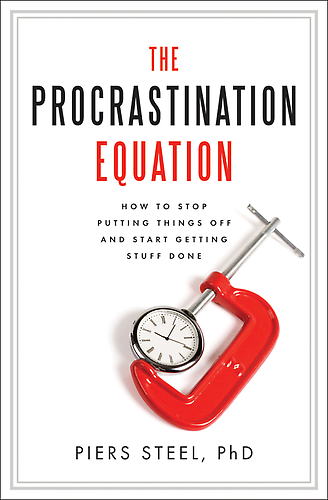by Alex Vermeer and Jimmy Rintjema

Why the hell can’t we get more done? We procrastinate. A lot. It sucks. We want to do it less.
The procrastination equation, thanks to Piers Steel, ((Piers Steel, from the University of Calgary, is “one of the world’s foremost researchers and speakers on the science of motivation and procrastination.”)) accounts for every major finding on human motivation and procrastination.
This procrastination equation is quite simple. We find it very useful. We want to explain how we use it in the hopes that you’ll find it useful too.
Motivation is…

What does it all mean?
- Motivation is self-explanatory; it’s basically the opposite of procrastination.
- Value refers to how much you enjoy doing a task, and how much you’ll enjoy the reward from completing it.
- Expectancy refers to how how much you expect to succeed at doing the task, and how much you expect to get the reward.
- Impulsiveness refers to your tendency to get distracted and your ability to stay focused.
- Delay refers to the fact that the further away a task’s reward or completion is, the less motivated we will be. ((This is because of hyperbolic discounting—the tendency humans have to value things less when they are further away, whether it’s in time, in location, or in concreteness.))
More value and expectancy pulls up motivation. Move impulsiveness or delay drags it down. Said another way: less value and expectancy increases procrastination, while less impulsiveness and delay simultaneously reduced procrastination.
Bring it down to earth, man…
Here are just a few examples of things that make you procrastinate, and the part of the equation that causes them:
- Can’t decide what to work on next (high I)
- Don’t know what you want (low V)
- Too many different things to do (high I or low E)
- Unclear priorities (low V)
- Lack of confidence in own abilities (low E)
- The work is boring (low V)
- The work is too difficult (low E or V)
- The project is too big/long (high D)
- The reward is months away (high D)
- Fear of failure (low E)
- Fear of judgement (low E)
- Don’t actually support the goals/outcome of the project/task (low V)
- Don’t expect to get any recognition for completing this thing (low E)
- Keep getting distracted (high I)
- Keep getting interrupted (high I)
- Goals are too abstract, vague (high D)
- Goals are too far away or distant (high D)
- Keep getting strong, intense cravings (I)
 Imagine you’re avoiding practicing saxophone. Though the numbers are completely arbitrary, let’s rate each factor of the equation on a scale of 1 to 10 where 1 is very bad and 10 is very good. How does practicing saxophone rank?
Imagine you’re avoiding practicing saxophone. Though the numbers are completely arbitrary, let’s rate each factor of the equation on a scale of 1 to 10 where 1 is very bad and 10 is very good. How does practicing saxophone rank?
- V=10 – You think this is incredibly valuable, and you realize this on a deep level.
- E=5 You are fairly good at sax already, but your abilities may have plateaued somewhat. It’s going to take a lot of effort to reach the next “level” of ability. Your expectancy of getting there is moderate.
- I=2 Every time you sit down to practice, you inevitably look up a YouTube video to “get inspiration” or to learn about a specific technique or song. But this leads you to browsing the web rather than practicing.
- D=2 It’s tough to imagine being an expert saxophonist based on where you are right now. You know you’ll get there eventually, but it’s obvious that the road is long and the “end” is not close at hand.
Since Value is nice and high, your motivation can be improved by increasing Expectancy, decreasing Impulsiveness, or decreasing Delay.
So, What Exactly Do We Do?
Step 1. Notice we’re procrastinating
First and foremost, notice when you’re procrastinating. Did you just spend the last half hour making progress on a specific task, or did you wander around Facebook and Buzzfeed? Ask yourself what you were trying to work on before you procrastinated. Was it specific? Did you have all the tools you needed? Was it going to take several hours or several days to accomplish? Can you break it down into manageable chunks?
Step 2. Ask: “Why am I not doing this?”
Try to identify where the problem is. The problem will generally fit into one or two of the four categories.
- “I just don’t want to do this right now because I’ve got better things to do.”
- “Ah, I don’t give a crap about the result because no one notices my work.”
- “I totally don’t think it’s going to work because I suck at designing these things.”
Step 3. Clearly identify which part(s) of the equation are the problem
- “My co-workers keep interrupting me” = Impulsiveness
- “I do this every day and it doesn’t make a difference.” = Value
- “Meh, I’ll work on that later. It’s going to take months to get it all done anyway.” = Delay
Step 4. Do something to fix the problem
- If you’re struggling with distractions or interruptions (Impulsiveness), modify your environment. Put on headphones. Close the door. Turn off your notifications and mobile phone.
- If you feel like the task is meaningless (Value), is it part of a whole that actually has greater value? Take five minutes and deeply picture the task being completed and you advancing toward the greater goal that you want to achieve.
- If the deadline is so far away that you continually put a task off (Delay), try setting a timer for ten minutes and working on the task or project for a short amount of time.
- If you’re worried about failure or criticism (Expectancy), try imagining the worst-case scenario or what would happen if you made no effort at all.
- If you can’t figure it out, try writing down how you feel and what you think the problem is or talk about it out loud to a friend.
Step 5. Consider another option
If you are not on a tight deadline and just can’t seem to solve the problem, is there something else you can work on and finish instead? Are you completely physically tired or feeling ill? Perhaps you’ve got a biological restriction that is overriding your motivation. Would a power nap or a ten minute walk help generate some positive energy?
Step 6. Don’t overthink it
Spending lots of time contemplating your procrastination might actually be procrastination. Sometimes, just starting is the biggest hurdle to overcome. Take a deep breath, stop thinking about all the other things that surround the task or project, and just spend a few minutes actually working on it.

Extra Stuff We’ve Found Useful
Here’s a collection of extra ideas and thoughts that we’ve found useful when using the procrastination equation:

- Troubleshoot your biology – sometimes all you really need is a splash cold water on your face, have a coffee, go for a run, or do some jumping jacks to get your energy flowing.
- Use social accountability – to using the equation.
- Plan around energy – plan around your natural energy and motivation levels, not your time.
- Keep a record – know what works best for you (or at the very least try to be conscious of what’s working and store it in memory).
- Drop the unimportant – if it can wait, leave it for now. Sometimes you’ll realize that something is actually not worth doing, in which case, drop it!
The Procrastination Equation Does Not Solve All Problems
Despite its usefulness, don’t make the mistake of treating the procrastination as a panacea—it’s not the only tool needed in your anti-procrastination toolbox. The procrastination equation:
- Does not tell you what you should be working on in the first place. A general lack of apathy is a sorta different problem that requires a different plan of attack.
- Does not help in situations where you have a lack of autonomy, e.g. where you have to wait for other people to do things; this isn’t a problem with motivation.
Additional Resources
Alex’s How to Get Motivated poster
The Procrastination Equation by Piers Steel
///




